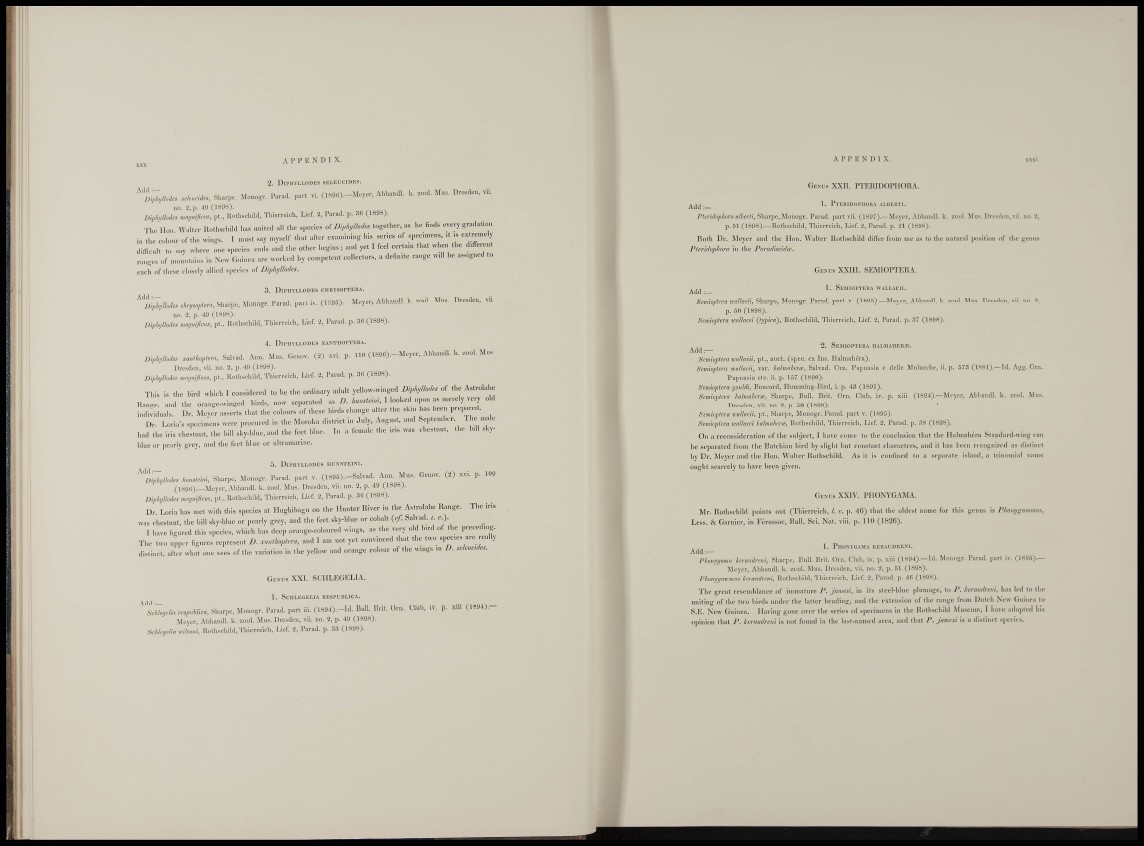
a p p e n d i x .
•2. Di p h v l l o b e s seleucides.
Sha.-pc. Monogv. Farad, part .i. (1830) . - M e y e r , Abhandl. k. zool. Mus. Dresden, vii,
no. 2,1). 49 (1808).
Dqih,,nodes mmjmficm, pt., Rothsdiild, Thierreich, Lief. 2, Parad. p. 30 (1898).
T l . e ' l l o , , Walter Kathscluld lu.s united all the speeies oiDiplyllodes together, as he 6„ds every gra.latlon
i„ ,he colour of the wings. I nu.st say n.yself that alter e.aumnng his series of specimens, ,t is extremely
ffi It to say where one species ends and the other begins ; and yet I feel certa.n that when the different
ranges of n.o.fntains iu New Guinea are worked by competent collectors, a definite range will be assigned to
each of these closely allied spccics of D'lphijUoiles.
Add:—
3 . DIIMIVLLODES C11RYS0PTEU.4.
cku„tera, Sharpe, Monogr. Parad. part iv. (1895) . - M e y e r , Abhandl. k. zool. Mus. Dresden, vii
no. 2, p. 49 (1898).
DiphjUodcs masnifaus, pt., Rothschild, Thierreich, Lief. 2, Parad. p. 36 (1898).
4 . Dll'IlVLLOnES XANTIIOI'TEKA.
Viph,,nodes .anthoftem, Salvad. Ann. Mus. Genov. (2) xvi. p. 110 ( 1 8 9 G ) . -Me y e r , Abhandl. k. zool. Mus
Dresden, vii. no. 2, p. 49 (1898).
Diphjnodes magmfics, pt., Rothseliild, Thierreich, Lief. 2, Parad. p. 3C (1898).
This is the bird which I considered to be the ordinary adult yellow-winged DIphi/lMes of the Astrolabe
Ilange, and the orange-winged birds, now separated as U looked upon as ineiely very old
indiv iduals. Dr. Meyer asserts that the colours of these birds change after the skin has been prepared.
Dr. Lorias si.ecimens were procured in the Moroka district in July, August, and September. J he male
had the iris chestnut, the bill sky-blue, and the feet bbie. In a female the iris was chestnut, the hdl skyblue
or pearly grey, and the feet blue or ultramarine.
5. Di i ' h y l l o d e s hunsteini.
^%yllodes l.,„.iei„i, Sharpe. Monogr. Parad. part v. (1895) . - S a l v a d . Ann. Mus. Genov. (2) xvi. p. 109
(189(5) _Me y e r , Abhandl. k. zool. Mus. Dresden, vn. no. 2, p. 49 (1898).
Diphyllodes magnifiers, pt., Rothschild, Thierreich, Lief. 2, Parad. p. 36 (1898).
Dr Loria has met with this species at Hughibagu on the Hunter River in the Astrolabe Range. The iris
was chestnut, the bill sky-blue or pearly grey, and the feet sky-blue or cobalt ( r f . S a lvad. i c ) .
I have fio-urcd this sp'ecies, which has deep orange-coloured wings, as the very old b,rd of the preceding.
T h e two u .per figures represent D. .unthoftera, and 1 am not yet convinced that the two species arc really
distinct, after what one sees of the variation in the yellow and orange colour of the wings in D. seleucuks.
Ge n u s XXI. SCIILEGELIA.
I . SCHLEGELIA RESl'UULICA.
S h a r p e , Monogr. Parad. part i i i . ( l ^ Club, iv. p. xiii (1894).-
i l e y e r , Abhandl. k. zool. Mus. Dresden, vii. no. 2, p. 49 (1898).
Sehkgelia wilsoni, Rothschild, Thierreich, Lief. 3, Parad. p. 33 (1898).
A P P E N D I X .
Genus XXII. PTERIDOPHORA.
. 1. I'tERIDOPHOKA ALIiEllTI.
Ptpi-idophom allcrii, Sharpe, Monogr. Parad. part vii. (1897).—Meyer, Abhandl. k. zool. Mus. Dresden, vii. no. 2,
p. 61 (1898).—Rothschi ld, Thierreich, Lief. 2, Parad. p. 21 (1898).
Both Dr. Meyer and the Hon. Walter Rothschild differ from nie as to the natural position of the genus
Pteridophorn in the Par(i(Usci(lcc.
Genus XXIII. SEMIOPTERA.
, , , 1. Semiopteiia wallacii.
Add:—
Semioptera wdlacii, Sharpe, Monogr. Parad. part v. (189.")).—Meyer, Abhandl. k. zool. Mus. Dresden, vii. no. 2,
p. 50 (1898).
Smiopiera wanaeei (typica), Rothschild, Thierreich, Lief. 2, Parad. ]». 37 (1898).
. , , 2. Semioptera iiALMAnEua;.
A d d : —
SemiopUra wallacii, pt., auct. (spec, ex Ins. Halmahera).
Semioptera wallacii, var. halmahera, Salvad. Oni. Papnasia e dclle Molucche, ii. p. 073 (1881).—Id. Agg. Orn.
Papuasia etc. ii. p. 157 (1890).
Semioptera (jonldi, Boucard, Hnmming-Bird, i. p. 43 (1891).
Semioptera halmahera:, Sharpe, Bull. Brit. Orn. Club, iv. p. xiii (1894).—Meyer, Abhandl. k. zcol. Mus.
Dresden, vii. no. 2, p. 50 (1808).
Semioptera u-allcicii, pt., Shai-pe, Monogr. Parad. part v. (1895).
Semioptera wallacei halmahera!, Rothschild, Thierreich, Lief. 2, Parad. p. 38 (1898).
On a reconsideration of the subject, I have come to tlie conclusion that the Halmahera Standard-wing can
he separated from the Batchian bird by slight but constant charactcrs, and it has hcen n cognizcd as distinct
by Dr. Meyer and the Hon. Widtcr liotlischild. As it is confined to a separate island, a trinomial name
ought scarcely to have been given.
Genus XXIV. PHONYGAMA.
Mr. Rothschild |ioinls out (Thierreich, I. c. p. 40) tliat the oldest name for this genus is Phomjgarmmih,
Less. & Gamier, in Ferussac, Bull. Sci. Nat . viii. p. 110 (1820).
A d d : —
1. PlIONVGAMA KERAUDRENI.
Phomjgama Iteraudre-m, Sharpe, Bull. Brit. Orn. Club, iv. p. xiii (1894).—Id. Monogr. Parad. part iv. (1895).—
Meyer, Abhandl. k. zool. Mus. Dresden, vii. no. 2, p. 51 (1898).
Phomjgammus keravdreni, Rothschild, Thierreich, Lief. 2, Parad. p. 4(> (1898).
The great reseinblance of immature P. jamesi, in its steel-blue ]ilnniage, to P. Icerauiheni, has led to the
uniting of the two birds under the latter heading, and the extension of the range from Dutch New Guinea to
S.E. New Guinea. Having gone over the series of specimens in the Rothschild Museum, I have adopted his
opinion that P. heruudreni is not found in the last-named area, and that P. jamesi is a distinct species.